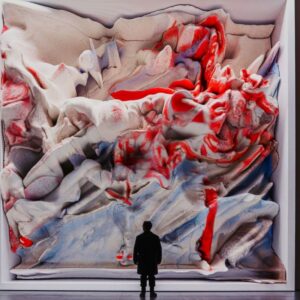Art
Virtual Reality Techniques in Art Exhibitions
Introduction
Virtual Reality (VR) has emerged as a transformative technology across various industries, from entertainment to education. One of the most intriguing applications of VR is in art exhibitions, where it is revolutionizing how art is presented and experienced. This article explores the integration of VR into art exhibitions, examining its impact on audience engagement, artistic expression, and the future of art curation.
The Evolution of Virtual Reality in Art Exhibitions
Virtual Reality, initially associated with gaming and simulation, has evolved into a powerful tool for artistic expression and exhibition. Historically, art exhibitions were confined by physical spaces and traditional display methods, limiting how art could be interacted with and experienced. However, as VR technology has advanced, it has opened new avenues for artists and curators to explore.
The early use of VR in art exhibitions involved creating virtual galleries where viewers could explore art in a digital space. Over time, this technology has become more sophisticated, allowing for interactive and immersive art experiences. This evolution has enabled artists to push the boundaries of their work and provide audiences with novel ways to engage with art.
Creating Immersive Art Experiences
One of the most significant benefits of VR in art exhibitions is the ability to create immersive experiences. Traditional art exhibitions typically offer a two-dimensional view of artworks, constrained by the physical limitations of the gallery space. VR, however, allows for a 360-degree exploration of art, enabling viewers to interact with and experience pieces in entirely new ways.
For instance, VR can transport visitors to a digital recreation of a famous gallery or art piece. This virtual environment can be designed to highlight specific details, provide historical context, or offer interactive elements that enhance the viewer’s understanding and appreciation of the artwork. This level of immersion is particularly impactful for artworks with intricate details or complex narratives that benefit from a more dynamic presentation.

Enhancing Artistic Expression
VR not only transforms the viewer’s experience but also expands the creative possibilities for artists. Traditional art forms are often limited by physical constraints, such as the size of the canvas or the materials used. VR removes these limitations, allowing artists to create works that exist purely in the digital realm.
Artists can use VR to develop interactive installations where viewers become active participants in the art. For example, an artist might create a virtual environment where users can manipulate elements of the artwork, influencing its appearance or outcome. This interactivity adds a new dimension to art, encouraging viewers to engage more deeply with the work and explore their own creativity.
Furthermore, VR enables the creation of three-dimensional art that can be experienced from multiple angles. This is particularly useful for exploring spatial concepts and creating immersive narratives. For instance, an artist might design a virtual space that users can walk through, experiencing the artwork in a way that traditional media cannot provide.
Case Studies: Successful Virtual Reality Art Exhibitions
Several notable art exhibitions have successfully integrated VR technology, demonstrating its potential to transform the art world. One prominent example is the “Van Gogh: The Immersive Experience” exhibition. This VR experience allows visitors to step into Vincent van Gogh’s paintings, exploring his vibrant and dynamic world in a fully immersive environment. The exhibition has been widely praised for its innovative approach and ability to bring van Gogh’s art to life in a new and engaging way.
Another example is the “The Night Cafe VR” experience, which recreates van Gogh’s famous painting “The Night Cafe” in virtual reality. This project allows users to explore the painting in 3D, providing a fresh perspective on the artwork and enhancing the viewer’s connection to it. Such projects highlight the potential of VR to offer unique and memorable art experiences.
Challenges and Considerations
Despite its many advantages, integrating VR into art exhibitions presents several challenges. One of the primary issues is the cost associated with VR technology. High-quality VR experiences require advanced equipment and software, which can be expensive to produce and maintain. This cost may pose a barrier for smaller galleries and independent artists who wish to explore VR.
Additionally, accessibility is a significant concern. Not everyone has access to VR equipment, and some individuals may experience discomfort or motion sickness while using VR headsets. Art institutions must consider these factors when designing VR exhibitions to ensure that they are inclusive and accessible to all viewers.
The Future of Virtual Reality in Art Exhibitions
Looking ahead, the future of VR in art exhibitions appears promising. As technology continues to advance, VR is likely to become more affordable and accessible, paving the way for even more innovative applications in the art world. Future developments may include enhanced haptic feedback, allowing users to feel and interact with virtual objects more realistically. Additionally, the integration of artificial intelligence (AI) with VR could lead to more personalized and interactive art experiences, further blurring the line between the viewer and the artwork.
The ongoing evolution of VR technology also suggests that art exhibitions will increasingly embrace digital and interactive elements. Artists and curators will continue to explore new ways to use VR to create immersive environments and engage audiences in novel ways. As VR becomes a more integral part of the art world, it will likely contribute to the development of new art forms and exhibition practices.
Conclusion
Virtual Reality is reshaping the landscape of art exhibitions, offering exciting new possibilities for both artists and audiences. By creating immersive experiences and expanding the boundaries of artistic expression, VR is transforming how art is presented and experienced. While there are challenges to overcome, the benefits of VR in art exhibitions are clear, and the future holds many opportunities for further innovation. As technology continues to advance, VR will undoubtedly play a significant role in the evolution of the art world, providing new ways to engage with and appreciate art.
Learn more: zgladnews


